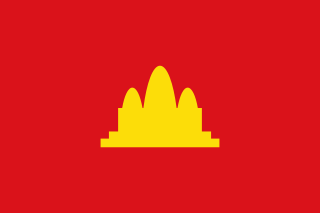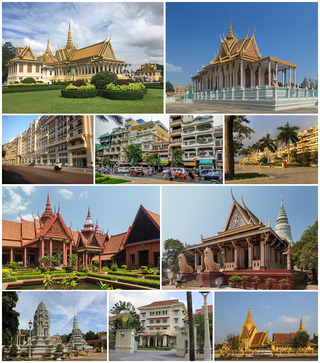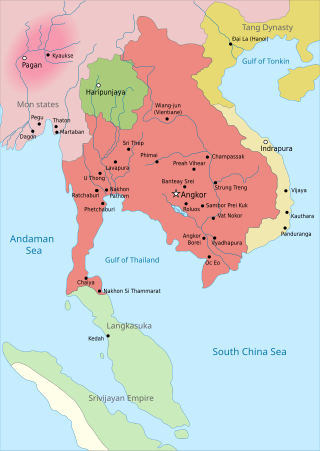Samleng Yuvachun (Voice of Khmer Youth) is a Khmer language newspaper published in Cambodia with its headquarters in Phnom Penh.
Samleng Yuvachun (Voice of Khmer Youth) is a Khmer language newspaper published in Cambodia with its headquarters in Phnom Penh.

The Austroasiatic languages, are a large language family in Mainland Southeast Asia and South Asia. These languages are scattered throughout parts of Thailand, Laos, India, Myanmar, Malaysia, Bangladesh, Nepal, and southern China. Austroasiatic constitute the majority languages of Vietnam and Cambodia. There are around 117 million speakers of Austroasiatic languages, of which more than two-thirds are Vietnamese speakers. Of these languages, only Vietnamese, Khmer, and Mon have a long-established recorded history. Only two have official status as modern national languages: Vietnamese in Vietnam and Khmer in Cambodia. The Mon language is a recognized indigenous language in Myanmar and Thailand. In Myanmar, the Wa language is the de facto official language of Wa State. Santali is one of the 22 scheduled languages of India. The rest of the languages are spoken by minority groups and have no official status.

Khmer is an Austroasiatic language spoken by the Khmer people, and the official and national language of Cambodia. Khmer has been influenced considerably by Sanskrit and Pali, especially in the royal and religious registers, through Hinduism and Buddhism. It is also the earliest recorded and earliest written language of the Mon–Khmer family, predating Mon and Vietnamese, due to Old Khmer being the language of the historical empires of Chenla, Angkor and, presumably, their earlier predecessor state, Funan.

Demographic features of the population of Cambodia include population density, ethnicity, education level, health of the populace, economic status, religious affiliations and other aspects of the population.

The Khmer Rouge is the name that was popularly given to members of the Communist Party of Kampuchea (CPK) and by extension to the regime through which the CPK ruled Cambodia between 1975 and 1979. The name was coined in the 1960s by then Chief of State Norodom Sihanouk to describe his country's heterogeneous, communist-led dissidents, with whom he allied after his 1970 overthrow.

Pol Pot was a Cambodian revolutionary, dictator, and politician who ruled Cambodia as Prime Minister of Democratic Kampuchea between 1976 and 1979. Ideologically a Marxist–Leninist and a Khmer ethnonationalist, he was a leading member of Cambodia's communist movement, the Khmer Rouge, from 1963 until 1997 and he served as the General Secretary of the Communist Party of Kampuchea from 1963 to 1981. His administration converted Cambodia into a one-party communist state and perpetrated the Cambodian genocide.

Phnom Penh is the capital and most populous city of Cambodia. It has been the national capital since the French protectorate of Cambodia and has grown to become the nation's primate city and its economic, industrial, and cultural centre.

The Khmer Empire was a Hindu-Buddhist empire in Southeast Asia, centered around hydraulic cities in what is now northern Cambodia. Known as Kambuja by its inhabitants, it grew out of the former civilisation of Chenla and lasted from 802 to 1431. Historians call this period of Cambodian history the Angkor period, after the empire's most well-known capital, Angkor. The Khmer Empire ruled or vassalised most of mainland Southeast Asia and stretched as far north as southern China. At its peak, the Empire was larger than the Byzantine Empire, which existed around the same time.

Cambodia or Kampuchea, officially the Kingdom of Cambodia, is a country in the southern Indochinese Peninsula in Southeast Asia, spanning an area of 181,035 square kilometres, bordered by Thailand to the northwest, Laos to the north, Vietnam to the east, and the Gulf of Thailand to the southwest. The capital and largest city is Phnom Penh.

The Cambodian Civil War was a civil war in Cambodia fought between the forces of the Communist Party of Kampuchea against the government forces of the Kingdom of Cambodia and, after October 1970, the Khmer Republic, which had succeeded the kingdom.
Khmer script is an abugida (alphasyllabary) script used to write the Khmer language, the official language of Cambodia. It is also used to write Pali in the Buddhist liturgy of Cambodia and Thailand.
The Khmer people are an Austroasiatic ethnic group native to Cambodia. They comprise over 90% of Cambodia's population of 17 million. They speak the Khmer language, which is part of the larger Austroasiatic-language family found in parts of Southeast Asia, parts of central, eastern, and northeastern India, parts of Bangladesh in South Asia, in parts of Southern China and numerous islands in the Indian Ocean.

The Cambodian–Vietnamese War, known in Vietnam as the Counter-offensive on the Southwestern border, and by Cambodian nationalists as the Vietnamese invasion of Cambodia, was an armed conflict between Democratic Kampuchea, controlled by the Khmer Rouge, and the Socialist Republic of Vietnam. The war began with repeated attacks by the Liberation Army of Kampuchea on the southwestern border of Vietnam, particularly the Ba Chúc massacre which resulted in the deaths of over 3,000 Vietnamese civilians. On 25 December 1978, Vietnam launched a full-scale invasion of Kampuchea, and subsequently occupied the country and removed the government of the Communist Party of Kampuchea from power.
The Khmer Krom are ethnically Khmer people living in or from the region of Tây Nam Bộ, the south western part of Vietnam. In Vietnam, they are recognized as one of Vietnam's fifty-three ethnic minorities: Vietnamese: Người Khmer and Người Cao Miên.

Kampuchea, officially known as Democratic Kampuchea from 5 January 1976, was a one-party totalitarian state which encompassed modern-day Cambodia and existed from 1975 to 1979. It was controlled by the Khmer Rouge (KR), the name popularly given to the followers of the Communist Party of Kampuchea (CPK), and was founded when KR forces defeated the Khmer Republic of Lon Nol in 1975.

The People's Republic of Kampuchea (PRK) was a partially recognised client state in Southeast Asia supported by Vietnam which existed from 1979 to 1989. It was founded in Cambodia by the Kampuchean United Front for National Salvation, a group of Cambodian communists who were dissatisfied with the Khmer Rouge due to its oppressive rule of Cambodia and defected from it after the overthrow of Democratic Kampuchea, Pol Pot's government. Brought about by an invasion from Vietnam, which routed the Khmer Rouge armies, it had Vietnam and the Soviet Union as its main allies.

Cambodian names are names used or originating in Cambodia which usually consist of two elements including a patronymic, which serves as a common family name for siblings, followed by a given name. An example is singer Sinn Sisamouth, his surname is Sinn and his given name is Sisamouth.

A wat is a type of Buddhist temple and Hindu temple in Cambodia, Laos, East Shan State, Yunnan, the Southern Province of Sri Lanka and Thailand. The word wat is a Thai word that was borrowed from Sanskrit vāṭa, meaning 'enclosure'. The term has varying meanings in each region, sometimes referring to a specific type of government-recognised or large temple, other times referring to any Buddhist or Hindu temple.

The Cambodian genocide was the systematic persecution and killing of Cambodian citizens by the Khmer Rouge under the leadership of Communist Party of Kampuchea general secretary Pol Pot. It resulted in the deaths of 1.5 to 2 million people from 1975 to 1979, nearly a quarter of Cambodia's population in 1975.
The fall of Phnom Penh was the capture of Phnom Penh, capital of the Khmer Republic, by the Khmer Rouge on 17 April 1975, effectively ending the Cambodian Civil War. At the beginning of April 1975, Phnom Penh, one of the last remaining strongholds of the Khmer Republic, was surrounded by the Khmer Rouge and totally dependent on aerial resupply through Pochentong Airport.